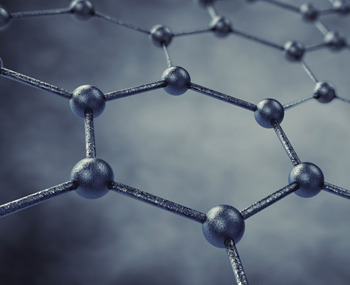Graphene

Graphene is the primary building block of graphite. A graphite crystal is much like a deck of cards, made up of many thousands of layers of only one atom thickness and held together held together by molecular interactions called van der Waals forces. Each “card” is a layer of graphene, composed of carbon atoms arranged in a hexagonal honeycomb lattice, much like chicken wire.
At one time, the isolation of a one atom thick molecule was considered to be physically impossible due to the instability of such a substance. However, it was finally isolated as a free standing structure in 2004 by a group of scientists at the University of Manchester, led by Andrei Geim and Konstantin Novoselov, by continuously peeling off layers from a natural graphite flake using sticky tape until they could go no further. This feat led to their being awarded the Nobel Prize in physics in 2010, amongst many other international awards and titles..
Importance of Graphene
Since the isolation of graphene was discovered in 2004, graphene has been the focus of academia, government labs and industry around the globe. Why?
Graphene is the strongest and most rigid substance known. It has the highest electrical conductivity of any substance known and can withstand temperatures well beyond current materials used in the field of electronics
The list of its unique properties is long and others are continually being discovered. We should be seeing very exciting new products incorporating this unique substance in the not too distant future.
A lot of research is being channelled into mass production of high quality graphene. Much of it may end up being produced synthetically where large continuous sheets are required, but for bulk applications such as stiffening fillers for composites, and where large scale perfection is not a requirement as with solar panels and LCDs, natural flake graphite, especially the large or jumbo flake will be a strong candidate as a source and will definitely have its place in graphene's and our future.
Dream touch-screens from graphene at Rice University
Flexible, transparent electronics are closer to reality with the creation of graphene-based electrodes at Rice University.
More Graphene Articles of Interest
May 12th 2012 | from the print edition
WRITTEN BY BEN FOUNTAIN ON 05 MAY 2011. POSTED IN HARDWARE
By Alex Hudson | BBC News
Solid State Technology
Graphene: World-leading Research and Development
Graphene is going to revolutionize the 21st Century
RICE UNIVERSITY NEWS & MEDIA
ZDNet
PHYSORG
